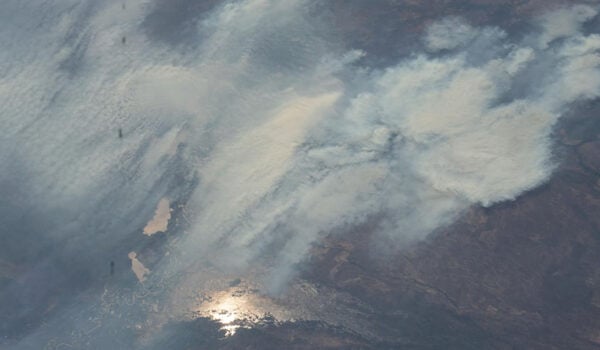Greenhouse gas concentrations, global temperatures across land and oceans, sea surface temperatures and wildfires: Several climate-related records were broken last year.
The 34th annual State of the Climate report states that in 2023, Earth’s greenhouse gas concentrations were the highest on record. The mean annual global sea-surface temperature in 2023 also reached record heights. In addition, it was the warmest year since records began in the mid to late 1800s.
Record-breaking wildfires
During late spring and a record-warm summer, approximately 37 million acres burned across Canada. This is an area more than twice the size of Ireland and more than double the previous record from 1989. Approximately 232,000 people were evacuated. Smoke from the wildfires not only impacted regions across Canada, it also affected the heavily populated cities of New York City and Chicago. On June 7th, the climate and environmental research institute NILU reported the smoke reaching Norway and other areas of western Europe.
It also burned heavily elsewhere in the world last year.
From mid-August to early September, the largest wildfire since the start of the record in 2000 for the European Union burned in the Alexandroupolis municipality of Greece. It burned almost 232,000 acres. Overall, the total area burned in Greece in 2023 was more than four times its long-term average.
With August to October 2023 being the driest three-month period in Australia in the record dating back to 1900, millions of acres of bushfires burned for weeks in the Northern Territory during September and October.
“Record heat often leads to record-breaking wildfires. To prevent such fires, removal of the biomass through for instance prescribed burning is key. If a fire then starts, it spreads more slowly and it’s easier to tackle,” says senior scientist Johannes Kaiser from the climate and environmental research institute NILU in Norway.
Kaiser is lead developer of the Global Fire Assimilation System software used by the Copernicus Atmosphere Monitoring Service (CAMS) to calculate the fire emission data. He is also the lead author of the section on global biomass burning in the State of the Climate report.
Biomass burning
CAMS scientists have contributed to the State of the Climate report for over a decade. Using CAMS reanalysis data, the service provides an analysis of aerosols, biomass burning and carbon monoxide. In 2023 the three parameters were highly influenced by the exceptional wildfires in Canada.
In addition to Johannes Kaiser, the biomass burning data was provided by Professor Dolors Armenteras from Universidad Nacional de Colombia and senior scientist Mark Parrington from CAMS / the European Centre for Medium-range Weather Forecasts (ECMWF).
Globally the biomass burning in 2023 is close to the 2003-2020 average, but the up to 20% share of the global wildfires’ emissions from Canada is outstanding. They pushed the global average of biomass burning emissions to an increase of approximately 25% in 2023 compared to the previous year. Overall, without the Canadian wildfires, global biomass burning would have continued to lie below the long-term average.
“The Canadian wildfires of 2023 really stand out as something we have never seen before. They are the most significant in 21 years of CAMS data records but probably unprecedented in several decades. Our forecasts predicted the phenomenon in good agreement with observations and the reanalysis data is a key contribution for the State of the Climate annual report,” said Mark Parrington.
The Canadian wildfires emitted five times more carbon emissions than the 2003-2020 average and three times more than the previous record.

CAMS analysis shows an important degree of interannual variability between regions and seasons, but also a clear trend towards an increase of wildfires in higher latitudes in recent years.
Other notable findings from the international report include:
Greenhouse gas concentrations
Carbon dioxide, methane and nitrous oxide – Earth’s major atmospheric greenhouse gases – once again reached record high concentrations in 2023.
Annual growth in global mean CO2 has increased from 0.6±0.1 ppm yr-1 in the early 1960s to an average of 2.5 ppm yr-1 during the last decade of 2014–23. The growth from 2022 to 2023 was 2.8 ppm, the fourth highest in the record since the 1960s.
Record temperatures notable across the globe
A range of scientific analyses indicate that the annual global surface temperature was 0.55 to 0.60 of a degree C above the 1991–2020 average. This makes 2023 the warmest year since records began in the mid to late 1800s, surpassing the previous record of 2016 by 0.13 to 0.17 of a degree C. The transition in the Pacific Ocean from La Niña at the beginning of the year to a strong El Niño by the end of the year contributed to the record warmth.
All seven major global temperature datasets used for analysis in the report agree that the last nine years (2015–23) were the nine warmest on record. The annual global mean surface temperature has increased at an average rate of 0.08 to 0.09 of a degree C per decade since 1880, and at a rate more than twice as high since 1981.
El Niño contributed to record-high sea surface temperatures
El Niño conditions in the equatorial Pacific Ocean emerged in boreal spring 2023 and strengthened throughout the year. The mean annual global sea-surface temperature in 2023 was record high, surpassing the previous record of 2016 by 0.13 of a degree C. Each month from June to December was record warm. On August 22, an all-time high globally averaged daily sea-surface temperature of 18.99 degrees C was recorded.
The ocean experienced a new global average record of 116 marine heatwave days in 2023, which was far more than the previous record of 86 days in 2016, and a new record of 13 marine cold spell days, far below the previous record of 37 days in 1982.







